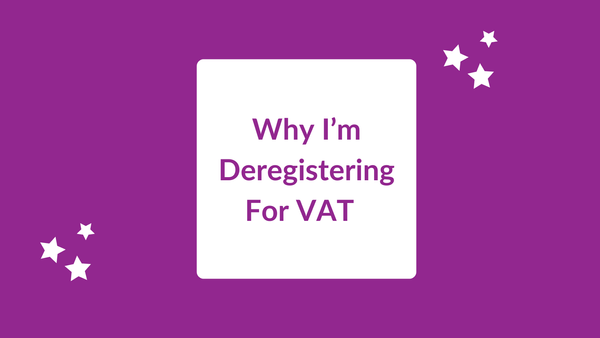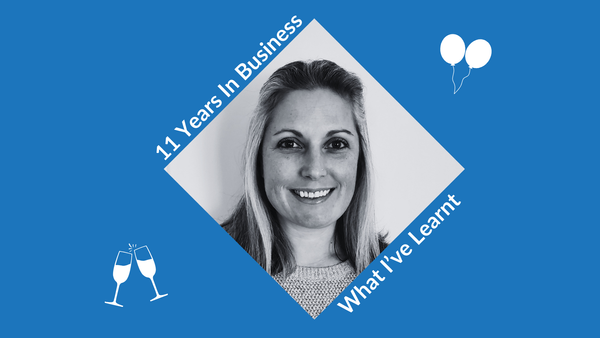Posting with Purpose
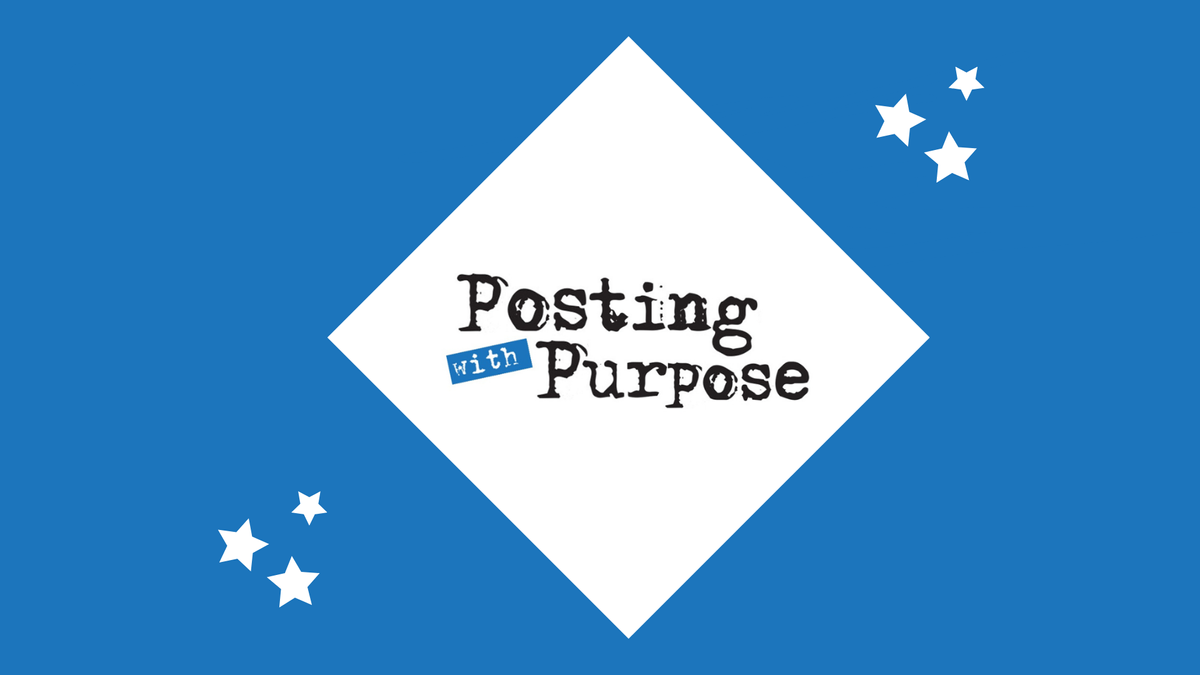
Do you struggle with social media content? Do you often feel as though you are posting for the sake of posting, hoping something will generate results eventually? Would you like to post with more confidence?
This 30-minute video outlines a simple strategy for creating content for social media. You’ll learn about the three types of content you should be posting, ideas for how to approach each type of content, and examples of content I’ve used on my own social media pages. I’ll also be sharing some common mistakes (and how to avoid them) and tips for building a “content bank” so you can stay consistent with your social media marketing.
If you prefer reading to watching, the entire transcript is posted below (with timings so you can refer back to the video if you need to).
Posting with Purpose: Video Transcript
Something that comes up quite often in my consultations and on my 12-week programme is social media.
A lot of people struggle with social media because they don't really know what they should be posting about.
Or they've been posting for a while, but then running out of ideas and they're starting to feel a bit burnt out.
Or they've been posting for a while but they just don't seem to be getting the results they were hoping to get from it.
Now, this can often happen because you're approaching social media without a real plan - you're posting without having any purpose behind your posts.
This can happen when you've been told “Oh you should be on social media, you need to be doing social media,” so you've gone on there and just started posting in the hope that something will stick.
Or maybe you have gone on with a strategy, with a plan, with objectives in mind, but you've just lost sight of that a little bit. And maybe you've got distracted by some of the wrong metrics and you're focusing more on going viral than actually what you set out to do, which was to attract more of the clients you want.
So what I'm going to do in this video is teach you a really simple social media strategy that I like to call posting with purpose.
The idea behind posting with purpose is simple. All I want you to do is every time you are putting a post on social media is think about two questions.
What is the purpose of this post?
Each post will have a different objective. Some posts will be designed to get engagement and increase your visibility, whereas other posts will be there to promote a specific product or service. And some posts might be there to help you establish expertise, build trust with your audience, or demonstrate your credibility.
If you're looking at each post individually and thinking about the purpose of each post, then you're going to be less concerned with the wrong metrics and more concerned with whether you're actually achieving what you're hoping to.
The other question that I want you to ask yourself is what do you want people to do, think or feel after reading this post?
It might be that you want them to take a specific action, so you want them to click through to your website, read a blog post or watch a video. Or you want them to get in touch by messaging you or emailing you. Or you want them to request some information or something else.
Or it might be that you want them to think or feel something different. Maybe you want them to start thinking about how your products or services could benefit them. Maybe you want them to feel confident in you and confident in your expertise and confident that you can deliver what you say you can.
And again, this will tie in with the purpose of your post. If you are trying to demonstrate your credibility, then you’ll want people to feel confident in you once they have viewed the post you're putting out.
So really think about the purpose of your post and what you want people to do, think and feel after they have read your post.
3 types of content (03:06)
For simplicity, I like to break my content down into three key categories.
The first category is what I like to call ‘attract’. This is content that is designed to increase your reach and grow your audience.
The second category is the ‘nurture’ category. This is content that is designed to generate interest in what you do, establish your expertise or build that trust and credibility.
And the final type of content is ‘convert’ so this is where you're promoting your products and services.
We're going to look at each of these three categories in more detail and I'm going to share the types of content that work well for these and some examples of content that I've created myself.
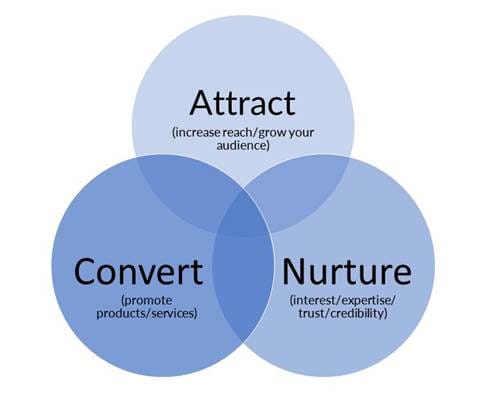
Attract (03:55)
First up is our ‘attract’ category. The objectives of this type of content are:
to get likes and shares or to start conversations,
to gain new followers or build connections,
to connect with new audiences and
to attract potential clients into our community.
The types of content that work well to meet these objectives are:
Content that entertains people such as memes or quizzes or funny pictures.
Content that sparks conversations or gets people talking in your comments section. A great way to do this is to ask a question inviting people to leave a comment.
Content that mentions others. So if you tag someone in a post or you tag a company in your post then they are going to see that post and some of their audience will see that post and they might even comment on that post or share that post, reshare that post with their audience.
Using hashtags. This will be dependent on the platform that you're using. Some platforms really like hashtags and this is a great way of getting your post in front of the right people. On other platforms, hashtags are not really used or aren’t really important.
Trending topics. I don't advocate jumping on every bandwagon that passes through town, but if there is something that is in the news or something that is current and it ties in with your business or it ties in with your industry, then absolutely use these topics as subjects for your content.
Being controversial. When I say controversial, I don't mean being antagonistic or sharing really out there opinions. You could be controversial in other ways.
Maybe there's an opinion in your industry that is widely accepted, but it's something that you disagree with, or you have a different viewpoint on so you can share that opinion and be controversial in that way.
Or maybe you're talking about a controversial topic, something that sparks a lot of debate. It doesn't have to get nasty. You can keep it friendly. You can keep it positive, but sometimes being controversial can be a great way of getting a lot of engagement on a post.
Insight into you or your company. Give people a little bit of insight into the person behind the business, your values, your hobbies, your interests, things that make you tick.
This doesn't mean that you have to share your deepest, darkest secrets. You can just talk about general hobbies and interests that you think might be interesting to other people.
Getting other people to promote you is a great way of increasing your reach or growing your audience is getting other people to promote you or your content.
If you've written a blog post or you've made a video or you've shared something that you think would be of interest to someone else's audience, then just drop them a message and say, hey, I've got this, I think your audience might be interested in it, do you want to reshare it?
So now I'm just going to share with you a couple of examples of where I've created this type of content on my social media pages so that you can see how it works.
Examples of ‘Attract’ content
So first up is a post that I wrote when I got a parkrun PB a few weeks ago and at the end I asked who else is a parkrun fan.
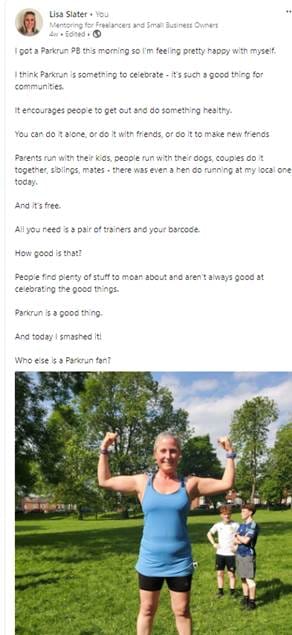
Parkrun is really popular, so I know a lot of people do parkrun or have seen parkruns in their area, so I knew this would get a lot of people talking, but it also gives people a bit of insight into me and shows them that I have hobbies and interests outside of business. So you can talk about a hobby or interest that you have and then start that conversation about it.
This next post was just a little bit of fun, asking what kind of LinkedIn user are you, where I've taken song lyrics and I've tweaked them a bit to make them relevant to LinkedIn. And then I asked people to let me know in the comments if they had any other ideas.
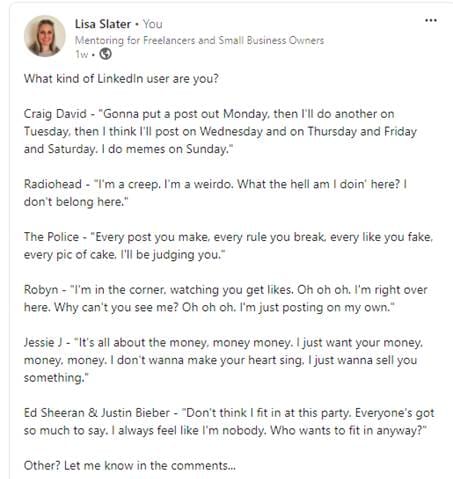
So this was just a bit of fun and I knew it would get engagement. A lot of people commented saying that they found it amusing. Some people put their own attempts at song lyrics in the comments and it just got people talking. And it got me quite a few new followers.
Another post that was designed to help me increase reach and grow my audience is this one where I am giving a shoutout to a company that I gave us fantastic service.
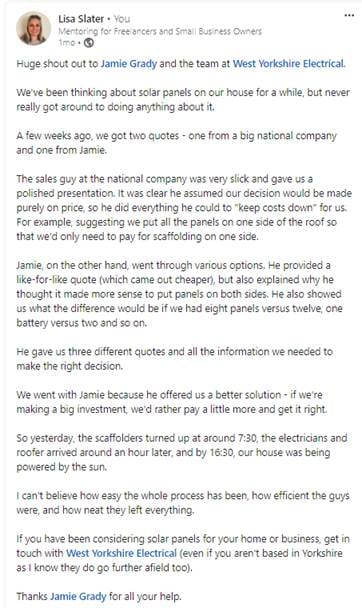
So we got some solar panels installed on our house and I wrote a post tagging the person who sorted this out for us and his company and talked about why we chose them over a competitor and what we liked about the service.
As you can imagine, he liked the post and commented on the post, which led some of his followers to see that post. And he also reshared that post to his network and I got a few new followers who saw my name come up and clicked through to my profile and decided I looked like someone that would be interesting to follow.
This last example is a poll that I put out on LinkedIn.
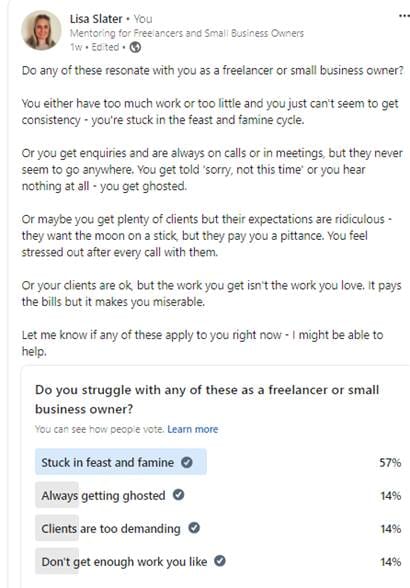
When you put a poll on LinkedIn, it tells you who's voted on your poll and which option they chose. So what I did after I posted this poll was contacting anyone that voted on it directly by messaging them saying “Thank you for voting on my poll. I noticed that you picked this option. And here's an article that might help you.”
So for the feast and famine option, I was messaging people telling them, “here's an article on how to avoid the feast and famine cycle - thought you might be interested.” And the same with the getting ghosted, “here's an article on how to avoid getting ghosted.”
So that's a great way that you can use posts to get engagement but then build on that engagement by connecting with people afterwards and taking the conversation away from the main feed.
And that brings me nicely on to the next part of using these ‘attract’ type posts.
The objective is to increase our reach and grow our audience, but we need to think about what we're going to do next.
The first thing that we should be doing is engage with the comments. If people have taken the time to comment on one of your posts or interact with one of your posts, then you acknowledge that they've done that. Reply to your comments and start those conversations, continue those conversations and acknowledge that people have taken the time to engage with your posts.
You can start conversations using direct messages, as I did with my poll example where I moved away from the main feed and contacted the people who engaged with that post by messaging them directly.
You could also send people a freebie if they've commented on a specific post, so you might have put a post out saying, “I've got some free content and anyone that comments I'll send it to them.”
Or it might be that you do something similar to what I did, so if they've voted a particular way on a poll, or if they've left a comment saying they have a specific problem, you can message them and send them a freebie. This could be a link to an article or a video, it could be a checklist, a guide, an ebook or something that you can give away for free relating to that post that you've put out.
You can even tag them in a future post on some platforms, people will tag new followers, “Hey, thanks to our new followers this week...”
It might be that you do events and someone’s commented saying, “this sounds really interesting but I can't make this date.” When you do the next event and you put a post out about it you could tag that person saying, “I know you couldn't make the last one but maybe this date works better for you?”
And you can nurture them. Once you've got some new followers or new connections, make sure that you're looking out for their posts and interacting with their content. Like their posts or comment on their posts, or even start conversations with them in the DMs, or share things with them that you think would be interesting.
Nurture (11:58)
That brings us on to the next type of content, which is your ‘nurture’ content. So the objectives of this type of content can be to:
- generate interest in what you offer
- strengthen your relationship with your audience
- establish your expertise
- build trust and
- demonstrate your credibility.
Types of content that work well to help you achieve these objectives include things like:
- Giving tips and advice.
- Sharing news, information or industry updates.
- Sharing your knowledge and experience and showing people that you know what you're talking about.
- Sharing common mistakes you see people make and talking people through how to avoid them.
- Using frequently asked questions.
Frequently asked questions can be a great subject for content, because if you're getting asked these questions face to face, then there are probably people out there who aren't asking you the questions who want the answer to those questions.
So use these questions as the subject of your content and answer these questions for the people who might have those questions in mind but might not be asking them.
So again, I'm just going to share some examples of where I've created this kind of content.
Examples of ‘Nurture’ content
The first example is a video of mine. It's actually a clip taken from a longer video about how to get your content seen by more people, but in this particular clip, I'm talking about how it's better to get fewer people seeing your content, and one of them becoming a customer than getting loads of people seeing your content and none of them becoming a customer
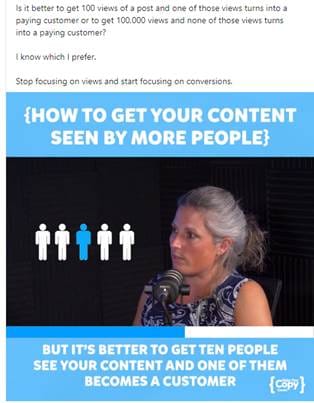
This post is just a straight-out text post where I'm talking about a big mistake people make with their content being only sharing it one time. This is a mistake I see a lot of people making with their content. They think that they have to come up with new content every time they post. You don't. It's perfectly fine to reuse content to reshare the same posts or to share blog posts or videos multiple times, even to share the same posts that you've shared before.
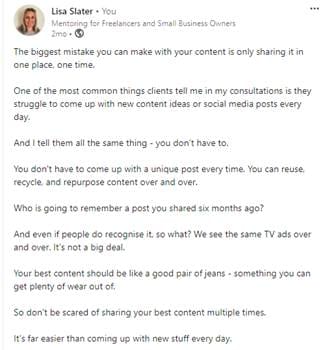
We see the same content a lot and when you share something on social media and not all of your audience is going to see it that first time you share it. And even those who do see it in their feed might not be paying attention. They might not be focused on it, they're just scrolling. But the next time you share it, they might see it.
Or it might be that they see the content and think, “oh, that's interesting, I want to read that but I haven't got time at the minute” and then they forget about it.
But then when they see it a few weeks later, they think, “Oh yeah, I wanted to read that.”
So it's worth sharing content over and over again.
And then this example is part of a carousel, so it's a slide show where I'm just talking people through how to turn their copy around so it talks more about the readers than themselves.
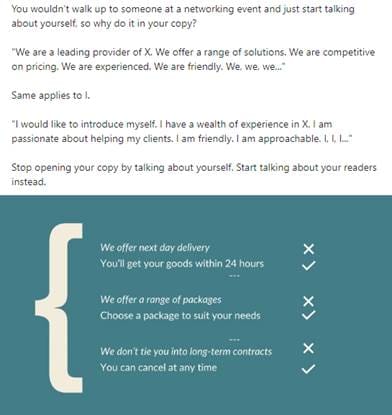
So these are just a few examples of where I am showing my expertise and demonstrating to people that I know what I'm talking about.
Convert (15:00)
So the final type of content we are creating is our ‘convert’ content.
This is the content that is designed to move people to the next stage of the funnel. And that might be that you want them to make a commitment such as signing up to your e-mail list or subscribing to your e-mail list.
It might be that you want them to make an enquiry. It could be that you want them to request some information (like to request a brochure or something like that).
It could be that you want them to book a call, appointment, or consultation. Or it might be that you want them to make a purchase.
Essentially, this is the type of content where you want people to take a specific action.
And the type of content that works well for this is:
Talking about problems that you solve. So showing people the problems that you solve and then telling them how you solve those problems for them.
Talking about different outcomes that you can deliver.
Sharing testimonials or case studies that demonstrate where you've actually done this, where you've actually solved these problems or delivered the outcomes that you're promising.
Sharing special offers if you've got any special offers on.
Or promoting a specific product or service, so just advertising your products and services, letting people know what it is that you sell so that if they are interested, they know how they can get in touch with you and how they can get access to that product or service.
Examples of ‘Nurture’ content
So again, I'm just going to show you some examples of where I've created this type of content myself.
This first one is a straightforward text post where I am outright saying “I help people attract more of the clients they want” and then explain how I do that.
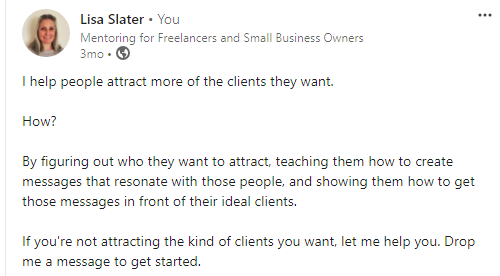
In this next post I've shared some feedback that I got from a client, so this was a recommendation that I was left on LinkedIn. I have turned that into an image and then I've written a post about it talking about how when you work with me one-on-one, you get the best of me.

This post is another carousel with different slides talking about the different things I can help with in my 90-minute sessions and sharing some testimonials and feedback from clients who have booked those sessions with me in the past. And in the text part of the post I have included a link for people to then go on to book a session with me.
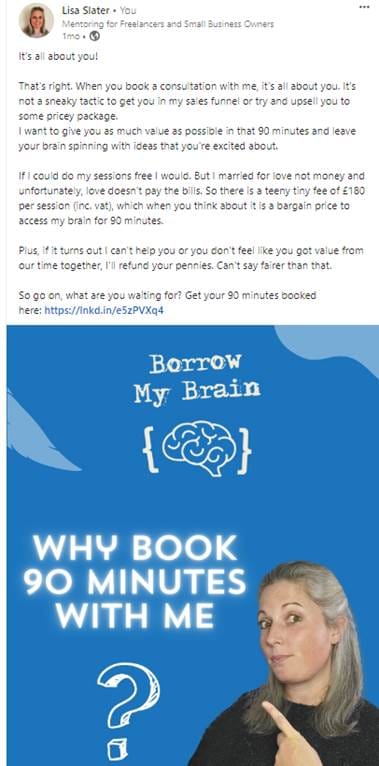
And this one is my promo video and the text that I've put with this is the script from the promotional video so that if people don't want to watch the video, they can just read the text that goes alongside it.
This is written in the form of a poem so it's a bit of fun, but it's also telling people about the problems I can solve.
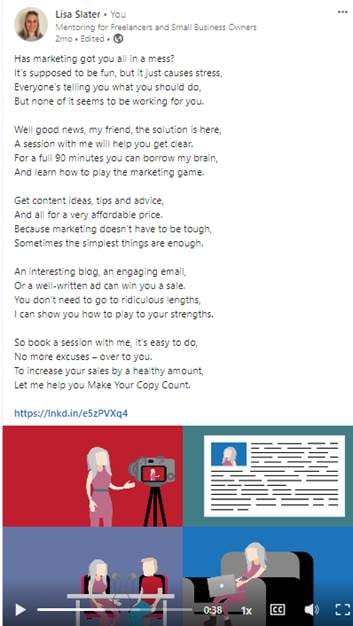
So it's talking about a specific problem people might be struggling with and then telling them how I can help them solve that problem and why they should book a session with me.
So there are ways of promoting your products and services without having to be pushy or sound too spammy.
A lot of people do worry about this. They find it hard to promote themselves or sell themselves because it feels uncomfortable to them.
But you can do it in a way that doesn't feel awkward or uncomfortable for you. And I can teach you how to do that if you are interested in learning how to write sales copy that doesn't feel uncomfortable to you.
Recap of three types of content
So there we have our three types of content. We've got our ‘attract’ content, this is the content that's going to help us increase reach and grow our audience.
We've got our ‘nurture’ content, the kind of content that is going to generate interest in what we do, establish our expertise, build that trust and demonstrate credibility.
And then we've got our ‘convert’ content, the content that is going to help us promote our products and services and get our clients to the next stage of that sales process.
Common mistakes (18:55)
Now we've covered the three types of content. I just want to quickly mention some of the common mistakes I see people making with their social media.
The first mistake I see people making is focusing too much on the first type of content, the ‘attract’ content. This is the content that is going to get the most likes and views. That's what it's designed for. That is the purpose of this type of content.
But what often happens is people see that this type of content gets more likes and views than the ‘nurture’ content or the ‘convert’ content, so they stop posting that type of content. They stop posting top tips and advice or they stop posting promotional content because it doesn't get as many views.
This is a mistake because if you're only posting content to get views and grow your following, you're just going to build a big audience but never actually convert any of that audience into paying clients.
In contrast, some people only share the second type of content, so they focus on giving value, giving tips and advice, showing they're an expert in their industry, giving people that valuable information. And this is great. We want to be doing that. We want to demonstrate that we're credible and that we know what we're talking about.
But we also have to let people know what we sell because if you're not telling people what you sell, they won't necessarily make that connection between the value that you're adding and the stuff that you actually do that's paid.
So make sure that you are mentioning in your products and services and promoting yourself because it is important to tell people what you're doing and ask for the sale.
And then of course, you've got the people who only share the third type of content, who only share promotional posts, who only appear when they've got something to sell or promote.
And it's not always necessarily that they're promoting paid services. Sometimes, for example, people offer free events and they'll turn up and talk about the next the date of their next event.
“Our next event is on this date. Make sure you book your place here.”
“Only one week to go until our next event. Book your place here.”
“Only three days to go until our next event.”
“Don't miss out on our next event.”
“Last chance to book our next event”
And then they'll disappear for a month, and then they'll pop up again with, “Hey, we've got another event on this date - make sure you book.”
So they're only turning up on people's feeds when they've got something to sell or when they're trying to promote something. And this can be annoying for people because social media is about give and take. It's not just about sell, sell, sell.
It's about engaging with people and building those relationships. So don't fall into the trap of only posting one type of content. Make sure you are creating a good mix of each type of content:
The ‘attract’ content to help you grow your audience.
The ‘nurture’ content to help you establish credibility, build that trust and establish your expertise
And then the ‘convert’ content where you're telling people what you actually sell so that they can engage with that and move to the next stage of your sales process.
Another mistake I see people making is not engaging with other people's content. Make sure you are being social.
A great way to expand your following is by engaging with other people's content liking posts, commenting on other people's posts, and resharing other people's posts. So make sure you are engaging with other people's content and you're not just post, post post, without giving anything back to your community. Once you've got those followers and connections, make sure you are engaging with them.
Another mistake is not replying to comments and messages. If people are commenting on your post, make sure that you are replying to those comments and acknowledging that they have taken the time and effort to comment on your post.
And if people are messaging you, if they're asking you questions about something you've posted or about your products or services, or they're trying to engage you in working with them, make sure you are replying to those messages.
And that brings me on to the next mistake I see a lot of people making, which is not moving people to the next stage. People can be very good at growing a big following and getting those connections, but then they don't actually do anything with that following.
As I said, when we were talking about the ‘attract’ type of content, you want to be nurturing these people. So once you've got their attention, once you've attracted them to you, how are you then moving them to the next stage? How are you engaging with them and nurturing them and getting them to join your e-mail list or join your webinar or book a call with you or do business with you?
And then the final mistake I want to mention is being inconsistent with social media.
I'm not suggesting that you need to be constantly on social media dedicating hours a week to social media or posting every day. But what you often see is people will come on to social media, have a flurry of activity, post loads and loads of content, and then suddenly disappear for months on end.
And this is what you don't want to be doing because this can seem like you're only turning up when you need something.
People often do this when they go through busy periods. They switch off their marketing because they're too busy to bother with it, or when they're not so busy, they start doing loads of social media activity because they need to get those leads.
The best way to avoid the feast and famine cycle is to be consistent with your marketing. So even when you're really busy, you still need to be marketing yourself. You still need to be visible.
And it's really easy to do with social media because you can schedule content to go out, you can pre-write posts, you can create a bank of content.
So even if you haven't got a lot of time to dedicate to social media, you can still be putting content out there consistently so that you're still visible to your clients and your potential clients.
Build a content bank (24:57)
The last thing I'm going to cover is how you can build a content bank so that you've got some content ready to go when you're not feeling creative, when you can't come up with new ideas or when you're just too busy to spend a lot of time on social media.
So I want you to just take 10 to 15 minutes to write down some of these things:
Problems you solve, so try and think of as many problems that you solve for your clients. And they can be really specific problems as well. So think about clients that you've had in the past. What problems did they come to you with? What problems do you commonly see people having that you can help with?
Outcomes you deliver. What kind of results do you get for your clients? What things do you help them with?
Frequently asked questions or questions that you've been asked recently by potential clients or your existing clients. What questions are you getting asked that you could turn into social media posts?
Common mistakes you see people making. What common mistakes do you see that you can help people avoid?
Top tips. What are the top tips that you're frequently sharing with people? Tips you're giving out when you're talking to people at networking events or when you're having meetings with clients.
Once you've got these ideas listed, turn them into social media posts. Spend a little bit of time pre-writing a handful of social media posts so that you've just got some of those posts ready to go whenever you need them.
The next thing I want you to do is go through your client reviews.
So whether that's LinkedIn recommendations, Google Reviews, Facebook reviews, or emails that you've had with nice feedback.
Think about how you can use these reviews as direct quotes, turn them into images or use them as screenshots in social media posts to help demonstrate that credibility.
Then I want you to go through any existing blog posts or videos that you've got and find any that are still relevant that you can reshare and repurpose and use as content going forward.
Make a list of the links to all these blog posts or the links to these videos, or put them all in a file where you can easily find them so you can use them on social media when you need them.
And then finally go back through your social media. If you've already been using social media for a while, have a look at past posts and find any that are still relevant that you could rewrite or reword slightly or just recycle as they are (because it's fine to reshare some of those posts that you've shared in the past).
Once you've got your newly written posts about the problems you solve, your frequently asked questions and those kind of things, and your client reviews, blog posts, videos and past posts that are still relevant, you’ve got a content bank. When you are too busy to come up with new content ideas, you've got plenty of content there that you can use so that you can stay consistent on social media.
And always make sure that you are constantly thinking about the purpose of each post. Why are you posting that post? What do you want people to do, think or feel once they've read that post?
So that's my ‘Posting with Purpose’ strategy.
There's not really a right or wrong way to do social media. The important thing is getting the results you want from it.
If you're already getting the results you want, then keep doing what you're doing. But if you're struggling to get the results that you want, then approaching social media with a little bit more structure and posting with purpose can help you improve on those results and start attracting the kind of clients that you want.
I hope you found this content useful and have taken some action points away from it.
If you would like a little bit more support, you can book one of my social media strategy sessions where we'll work together one-on-one to figure out a full social media strategy for you so you can start getting more of the clients you deserve.


